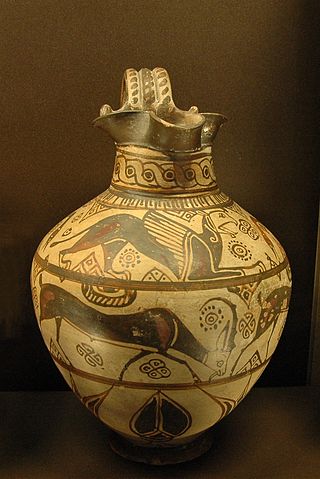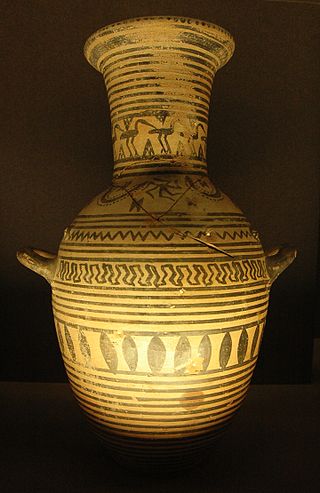
Black-figure pottery painting is one of the styles of painting on antique Greek vases. It was especially common between the 7th and 5th centuries BCE, although there are specimens dating in the 2nd century BCE. Stylistically it can be distinguished from the preceding orientalizing period and the subsequent red-figure pottery style.

Exekias was an ancient Greek vase painter and potter who was active in Athens between roughly 545 BC and 530 BC. Exekias worked mainly in the black-figure technique, which involved the painting of scenes using a clay slip that fired to black, with details created through incision. Exekias is regarded by art historians as an artistic visionary whose masterful use of incision and psychologically sensitive compositions mark him as one of the greatest of all Attic vase painters. The Andokides painter and the Lysippides Painter are thought to have been students of Exekias.

An oenochoe, also spelled oinochoe, is a wine jug and a key form of ancient Greek pottery.

A lekythos is a type of ancient Greek vessel used for storing oil, especially olive oil. It has a narrow body and one handle attached to the neck of the vessel, and is thus a narrow type of jug, with no pouring lip; the oinochoe is more like a modern jug. In the "shoulder" and "cylindrical" types which became the most common, especially the latter, the sides of the body are usually vertical by the shoulder, and there is then a sharp change of direction as the neck curves in; the base and lip are normally prominent and flared. However, there are a number of varieties, and the word seems to have been used even more widely in ancient times than by modern archeologists. They are normally in pottery, but there are also carved stone examples.

The Berlin Painter is the conventional name given to an Attic Greek vase-painter who is widely regarded as among the most talented vase painters of the early 5th century BC. There are no painter signatures on any of the Berlin Painter's attributed works. From the surviving vases, it is safe to assume that he was a major painter, there are over 400 vases and fragments attributed to him.

Epiktetos was an Attic vase painter in the early red-figure style. Besides Oltos, he was the most important painter of the Pioneer Group. He was active between 520 BCE and 490 BCE. His name translates as "newly acquired", which is most probably a reference to his slave status.

Psiax was an Attic vase painter of the transitional period between the black-figure and red-figure styles. His works date to circa 525 to 505 BC and comprise about 60 surviving vases, two of which bear his signature. Initially he was allocated the name "Menon Painter" by John Beazley. Only later was it realised that the artist was identical with the painters signing as "Psiax".

The Amasis Painter was an ancient Greek vase painter who worked in the black-figure technique. He owes his name to the signature of the potter Amasis, who signed twelve works painted by the same hand. At the time of the exhibition, "The Amasis Painter and His World" (1985), 132 vases had been attributed to this artist.

The pottery of ancient Greece has a long history and the form of Greek vase shapes has had a continuous evolution from Minoan pottery down to the Hellenistic period. As Gisela Richter puts it, the forms of these vases find their "happiest expression" in the 5th and 6th centuries BC, yet it has been possible to date vases thanks to the variation in a form’s shape over time, a fact particularly useful when dating unpainted or plain black-gloss ware.

The Revelers Vase is a Greek vase originating from the Archaic Period. Painted around 510 BCE in the red figure pottery style, the Revelers vase was found in an Etruscan tomb in Vulci, Italy. The painting is attributed to Euthymides. The vase is an amphora, painted with two scenes: one depicts three nude partygoers, and the other the Trojan hero Hector arming for battle. The work represents an early use of foreshortening and three-quarter views of figures in Greek vase-painting, breaking with earlier conventions of employing profile and frontal views. It is currently held in the Staatliche Antikensammlungen in Münich, Germany.
The Comast Group was a group of Attic vase painters in the black-figure style. The works of its members are dated to between 585 and 570/560 BC. The artists of the Komast Group are seen as the successors of the Gorgon Painter. Its most important representatives were the KX Painter and the slightly later KY Painter. They painted vases shapes that had been newly introduced to Athens or that had not previously been painted. Especially commonly painted by them were '’kothon’’ and lekanis. From Corinth, then still the centre of Greek vase painting, they adopted the Komast cup and the skyphos (known as kotyle. The KY Painter introduced the column krater. Also popular at the time was the kantharos. The group adopted the Corinthian habit of depicting komasts, after which the group is named. It provided the group’s most commonly painted motif. The komast scenes permit Attic artists for the first time to reach the artistic levels of middle-ranking Corinthian vases. While the older KX Painter still mostly painted animals and only the occasional komast scene, the komos became a standard motif for the KY painter and further inferior successors. It is not clear to what extent the painters of the group really cooperated. It is possible that they all worked in the same workshop. The group influenced later Attic vase painters, including the Heidelberg Painter. Works by the Komast Group were not only found in Attica, but appear to have been exported widely. Vases and fragments have been found at many sites, including Naukratis, Rhodes, Central Italy, Taras, and even Corinth.

The KX Painter was an Attic black-figure vase painter. He was active between 585 and 570 BC. Besides the KY Painter, the KX Painter was the main representative of the Comast Group, which succeeded the Gorgon Painter. His conventional name was allocated by John Beazley. He is considered the better and chronologically somewhat earlier representative of the group. He was the first painter in Athens to occasionally depict komasts on his vases, a motif adopted from Corinthian vase painting. He mainly painted skyphoi, lekanes, kothones and Komast cups. In contrast to later representatives of the group, he still mostly painted animals, in a more careful and powerful style than the Gorgon Painter. Some mythological scenes by him are also known. Especially famous are his small-fornat mythical scenes placed within animal friezes. The KX Painter can be considered the first Attic painter to achieve a quality at par with that reached in Corinth, then the dominant centre of Greek vase painting. Imitations of his works are known from Boeotia.

The KY Painter was an Attic black-figure vase painter. He was active between 585 and 570 BC.

The C Painter was one of the most important Attic black-figure vase painters. His works date to circa 575–550 BC. His conventional name was allocated by the archaeologist John Beazley. The C stands for "Corinthianising", a reference to the strong influence of Corinthian vase painting on the artist. He was successor to the Comast Group and used the relatively old-fashioned range of vessel shapes preferred by that group, including lekanis, tripod kothon and skyphos. In contrast, he also painted quite innovative lekythoi with pronounced shoulders, although the more conservative Deinaeira type was still in use by some workshops at his time. The C Painter was the first Attic vase painter to paint cups without an offset lip, the Merrythought cup.

Little-Master cups are a type of Attic black-figure cups, produced around the middle and third quarter of the sixth century BC. Their name is based on their fine small-format decoration. Little-Master cups are later in origin than Siana cups, but both types were produced over a considerable period of time. The Little Masters painted only the small upper frieze above the carination of the cup, at times also the lip or handle areas. It is probably that only few of the painters of Siana cups also painted Little-Master cups. One of the first artists to introduce the Little-Master cup in Athens was Kleitias. The change in decoration went along with a lengthening of the cup foot. The dedicated painters of Little-Master cups rarely painted larger formas, whereas painters primarily specialised in large vases are known to also have painted Little-Master cups. Stylistic comparison between larger and smaller formats of the period remains difficult.

The Little masters were a group of potters and vase painters who produced vases of the Attic black-figure style featuring well-done figures in miniature. They were active in Athens approximately 560–530 BC. They mainly produced Little-master cups: lip cups, band cups, and droop cups, but were not entirely limited to such shapes. The group includes:

A Siana cup is a type of Attic cup decorated in the black-figure technique. They are named after one of their find locations, the Necropolis of the ancient city of Siana on Rhodes. During the second quarter of the 6th century BC, Siana cups were the predominant cup shape in Athens. The shape remained popular later and was still being produced in large quantities during the era of the Little-Master cups.

The Phrynos Painter was an Attic black-figure vase painter, active in Athens between c. 560 and 545 BC. He was allocated the conventional name "Phrynos Painter" after the potter Phrynos, as he had painted three cups signed by the latter:

The Lysippides Painter was an Attic vase painter in the black-figure style. He was active around 530 to 510 BC. His conventional name comes from a kalos inscription on a vase in the British Museum attributed to him; his real name is not known.

Boeotian vase painting was a regional style of ancient Greek vase painting. Since the Geometric period, and up to the 4th century BC, the region of Boeotia produced vases with ornamental and figural painted decoration, usually of lesser quality than the vase paintings from other areas.




















